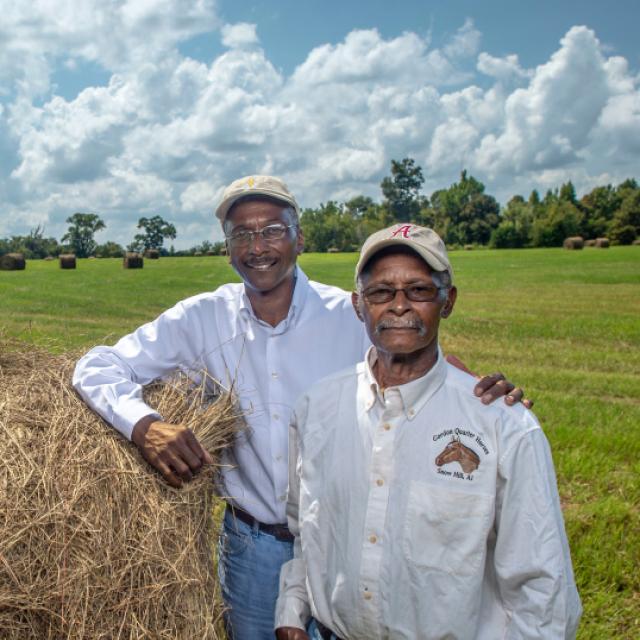
Conservation Innovation Grants (CIG) is a competitive program that supports the development of new tools, approaches, practices, and technologies to further natural resource conservation on private lands.
Through creative problem solving and innovation, CIG partners work to address our nation's water quality, air quality, soil health and wildlife habitat challenges, all while improving agricultural operations.
There are three annual Conservation Innovation Grants funding opportunities:
CIG Classic
National competition for projects that support the early-stage development and piloting of new tools, practices and technologies to further natural resource conservation on private lands.
CIG On-Farm Conservation Innovation Trials (On-Farm Trials)
National competition for projects that support more widespread adoption and evaluation of innovative conservation approaches in partnership with agricultural producers. On-Farm Trials Awardees provide technical assistance and incentive payments to producers to help compensate for risks associated with implementation of new conservation practices, systems and approaches. Awardees also evaluate the environmental, financial and social (to the extent possible) impacts of implementing innovative approaches. The Soil Health Demo Trial is a priority within the On-Farm Trials competition which focuses exclusively on implementation of conservation practices and systems that improve soil health.
State CIG Classic
State-level competitions for projects that support early-stage development and piloting of new tools, practices and technologies to further natural resource conservation on private lands. While the overall goal and approach match those of CIG Classic, CIG state competitions fund projects that target state-identified conservation priorities. Each year, NRCS state offices may elect to administer their own CIG competitions. State CIG competitions are announced separately from national competitions.
Explore CIG

CIG Projects
Since its inception in 2004, CIG has funded hundreds of projects, boosting natural resource conservation while helping producers improve the health of their operations for the future.

For Applicants
Information for applicants on the CIG program and how to apply.

For Grantees
Information for grantees who have been awarded funding for a CIG project.

Success Stories
CIG is making an impact across the country
Conservation Innovation Grants
USDA’s Natural Resources Conservation Service CIG program has three components: 1) State CIG competitions 2) the National CIG competition, and 3) the On-Farm Conservation Innovation Trials. Public and private grantees develop the tools, technologies, and strategies to support next-generation conservation efforts on working lands and develop market-based solutions to resource challenges. Grantees must match the CIG investment at least one to one.
Fiscal Year 2023 Iowa CIG Grant Proposals (Notice of Funding Opportunity)
Iowa NRCS is announcing the availability of CIG funding to stimulate the development and adoption of innovative conservation approaches and technologies. Applications are accepted from eligible entities for projects carried out in the state of Iowa. A total of up to $400,000.00 is available for the Iowa CIG competition in FY 2023. All non-federal entities (NFE) and individuals are invited to apply, with the sole exception of federal agencies. Projects may be between one and three years in duration. The maximum award amount for a single award in FY 2023 is $200,000.00. The grant proposal submission deadline is May 7, 2023.
2023 Iowa CIG Priorities
NRCS invites proposals that support one or more of the following Iowa priorities. See the full Announcement of Program Funding for additional information about each of the priorities.
- Soil Health/Climate Smart Ag
- Water Quality and Quantity
- Wildlife Habitat
- Urban Agriculture
- Equity/Reaching Underserved Customers
Application Process
The complete 2023 Iowa CIG Request for Applications is posted on Grants.gov, opportunity number USDA-NRCS-IA-23-CIG-NOFO0001243. The opportunity can be found easily on Grants.gov through the basic search criteria by using the opportunity number, or by searching the CFDA of 10.912. It can also be found by filtering for All Department of Agriculture.
Applications must be submitted electronically through grants.gov. Incomplete and/or non-compliant proposals will be eliminated from competition, and notification of elimination will be sent to the applicant.
Submissions must be received by the time and date due. Late submissions will not be reviewed or considered. The agency will rely on system generated date and time receipt documentation for submission made via Grants.gov to determine whether applications met the submission deadline.
For More Information
Jessica Phillips
Grants Management Specialist
Farm Production and Conservation Business Center
Email: jessica.phillips@usda.gov with a copy to FPAC.BC.GAD@USDA.GOV
Additional Information
Webinars
NRCS has established a webinar series to allow employees, partner conservationists and other interested stakeholders to hear directly from CIG grantees.
Fact Sheet
General information about the CIG program, who is eligible and how to apply.
Support for Historically Underserved Producers
CIG provides special consideration and benefits to Historically Underserved applicants and projects that support Historically Underserved producers.
Congressional Report
The 2021 Congressional report briefly describes the history of CIG and how the program is managed.
Ready to get started?
Contact your local service center to start your application.
How to Get Assistance
Do you farm or ranch and want to make improvements to the land that you own or lease?
Natural Resources Conservation Service offers technical and financial assistance to help farmers, ranchers and forest landowners.

To get started with NRCS, we recommend you stop by your local NRCS field office. We’ll discuss your vision for your land.
NRCS provides landowners with free technical assistance, or advice, for their land. Common technical assistance includes: resource assessment, practice design and resource monitoring. Your conservation planner will help you determine if financial assistance is right for you.
We’ll walk you through the application process. To get started on applying for financial assistance, we’ll work with you:
- To fill out an AD 1026, which ensures a conservation plan is in place before lands with highly erodible soils are farmed. It also ensures that identified wetland areas are protected.
- To meet other eligibility certifications.
Once complete, we’ll work with you on the application, or CPA 1200.
Applications for most programs are accepted on a continuous basis, but they’re considered for funding in different ranking periods. Be sure to ask your local NRCS district conservationist about the deadline for the ranking period to ensure you turn in your application in time.
As part of the application process, we’ll check to see if you are eligible. To do this, you’ll need to bring:
- An official tax ID (Social Security number or an employer ID)
- A property deed or lease agreement to show you have control of the property; and
- A farm number.
If you don’t have a farm number, you can get one from USDA’s Farm Service Agency. Typically, the local FSA office is located in the same building as the local NRCS office. You only need a farm number if you’re interested in financial assistance.
NRCS will take a look at the applications and rank them according to local resource concerns, the amount of conservation benefits the work will provide and the needs of applicants. View Application Ranking Dates by State.
If you’re selected, you can choose whether to sign the contract for the work to be done.
Once you sign the contract, you’ll be provided standards and specifications for completing the practice or practices, and then you will have a specified amount of time to implement. Once the work is implemented and inspected, you’ll be paid the rate of compensation for the work if it meets NRCS standards and specifications.

